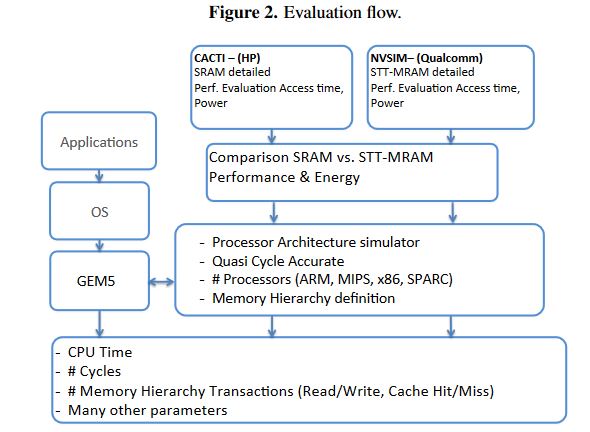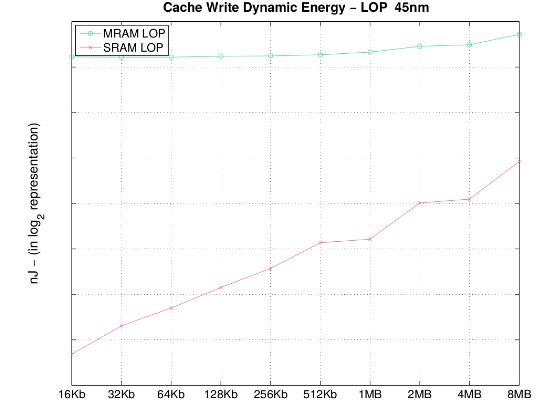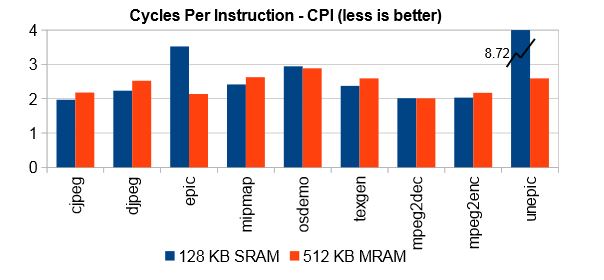ABSTRACT
Static random access memory (SRAM) is the most commonly employed semiconductor in the design of on-chip processor memory. However, it is unlikely that the SRAM technology will have a cell size that will continue to scale below 45 nm, due to the leakage current that is caused by the quantum tunneling effect. Magnetic random access memory (MRAM) is a candidate technology to replace SRAM, assuming appropriate dimensioning given an operating threshold voltage.
The write current of spin transfer torque (STT)-MRAM is a known limitation; however, this has been recently mitigated by leveraging perpendicular magnetic tunneling junctions. In this article, we present a comprehensive comparison of spin transfer torque-MRAM (STT-MRAM) and SRAM cache set banks. The non-volatility of STT-MRAM allows the definition of new instant on/off policies and leakage current optimizations.
Through our experiments, we demonstrate that STT-MRAM is a candidate for the memory hierarchy of embedded systems, due to the higher densities and reduced leakage of MRAM. We demonstrate that adopting STT-MRAM in L1 and L2 caches mitigates the impact of higher write latencies and increased current draw due to the use of MRAM. With the correct system-on-chip (SoC) design, we believe that STT-MRAM is a viable alternative to SRAM, which minimizes leakage current and the total power consumed by the SoC.
METHODOLOGY EVALUATION FLOW

Figure 2. Evaluation flow
In order to evaluate the impact of STT-MRAM applied in the memory hierarchy, we propose a full methodology flow, as depicted in Figure 2. For the flow, we defined a processor architectural simulator, in this case, the GEM5. The GEM5 simulator currently supports a variety of Instruction Set Architecture (ISAs) like Alpha, ARM, MIPS, PowerPC, SPARC and X86. The simulator modularity allows these different ISAs to plug into the generic CPU models and the memory system, without having to specialize one for the other.
STT-MRAM VS. SRAM MEMORY BANK COMPARISON

Figure 3. Total area (mm2)
In Table 3, depicted in Figure 3, we observe that increases to the memory size correspond to an area increase, as expected. However, the area of SRAM memory banks increases exponentially, while that of STT-MRAM increases linearly. One reason is the memory density: as we double the memory capacity, we indicate that the STT-MRAM density is 10–15 times higher than SRAM density according to (the explanation is in STT-MRAM; the MTJ at 45 nm has an area of 10 F2, while the SRAM cell has 146 F2).

Figure 7. Cache write dynamic energy (nJ)
In Table 7 and in Figure 7, we observe that STT-MRAM consumes 91 x more dynamic energy for a 16 KB memory bank; when the size of the DATA arrays increases, the difference decreases to 6.9 x (in 8 MB) of the write dynamic energy. This is due to the fact that an increase in memory bank size causes a linear increase in dynamic energy for STT-MRAM and an exponential increase when using SRAM.a
STT-MRAM APPLIED IN CACHE HIERARCHY

Figure 9. Same STT-MRAM silicon area versus SRAM L1 cache execution time comparison: 128-KB SRAM versus 512-KB MRAM
In Figure 9, we set an STT-MRAM L1 cache of 512 KB, and we compare it with an L1 128-KB SRAM cache size. It is shown that, for most benchmarks, they are comparable in terms of performance. In order to generalize this conclusion, let us then define the CPI penalty as the increase in the CPI caused by replacing an SRAM cache with an STT-MRAM cache using the same silicon area, as follows.
CONCLUSION
In this article, we have demonstrated that STT-MRAM can replace SRAM in the memory hierarchy of a microprocessor. We achieve this conclusion based on our memory hierarchy evaluation methodology flow. Using this flow, we have investigated the performance and power characteristics of STT-MRAM, when used as a replacement for SRAM. Although STT-MRAM has higher latencies, the lower leakage power of STT-MRAM, as compared to SRAM, makes it an attractive candidate replacement technology.
Current results indicate that it could be a solution to address the rising power consumption of CMOS circuits. The use of STT-MRAM enables the possibility of new techniques for the implementation of power-saving mechanisms. The non-volatility could be explored to power-off the devices whenever they are idle. Furthermore, non-volatile memory arrays do not need refreshing, reducing the dynamic power and leakage. Independently of our results, the physical properties used in our evaluation of STT-MRAM produce two possible pathways for integrated circuit design.
In one, we can conserve the total silicon die area and increase the amount of memory at least four-fold, or we could maintain thesame amount of memory, but increase the production yield of the circuit four-fold by switching from SRAM to STT-MRAM. Given our evaluation and the benefits STT-MRAM brings to integrated circuit design, we conclude that STT-MRAM is a strong candidate to replace SRAM in the memory hierarchy of microprocessors.
Source: University of Montpellier
Authors: Luis Vitorio Cargnini | Lionel Torres | Raphael Martins Brum | Sophiane Senni | Gilles Sassatelli